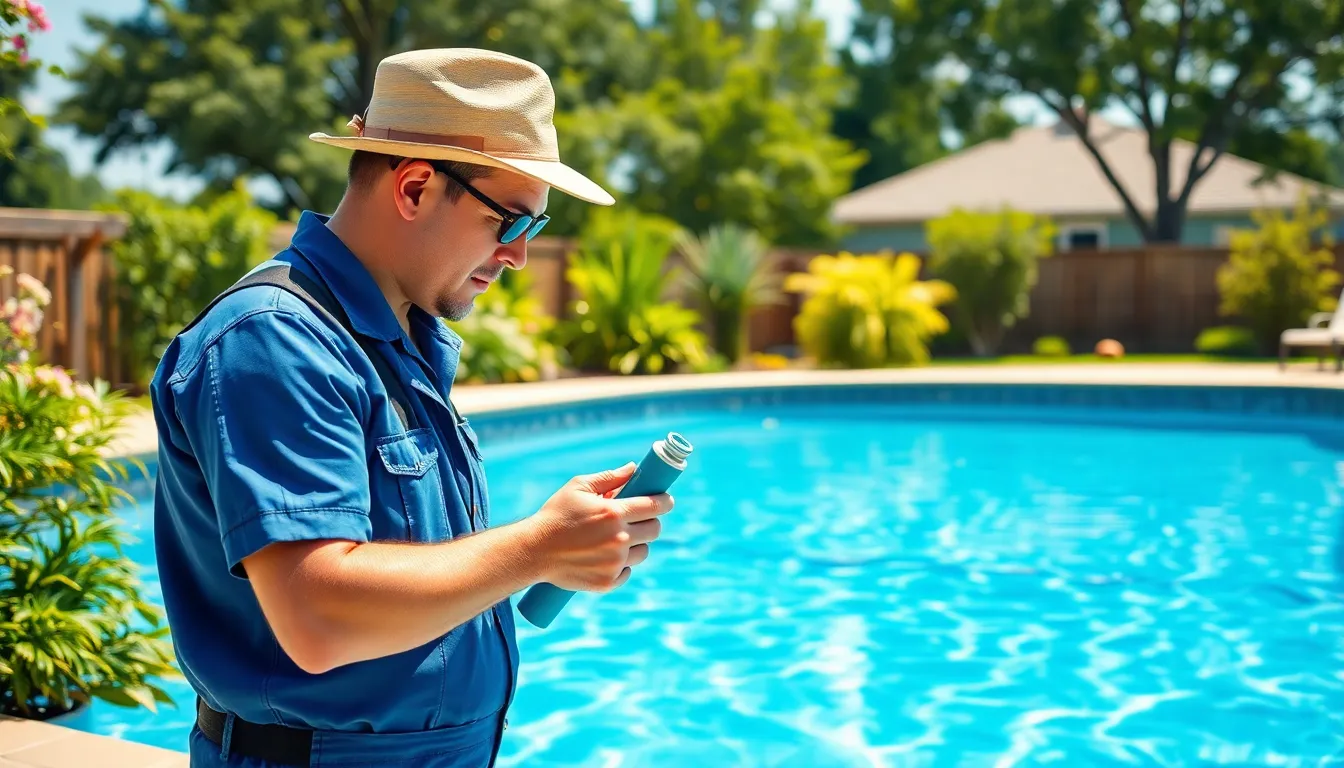Table of Contents
ToggleOwning a pool can feel like a dream come true, but maintaining it? That’s a whole different splash. While lounging poolside with a drink in hand sounds fantastic, the reality of pool maintenance costs can leave some homeowners feeling a little wet behind the ears. From chemicals to equipment repairs, the annual expenses can add up faster than a cannonball splash.
Overview of Pool Maintenance Costs
Pool maintenance costs vary significantly based on location and pool type. Homeowners spend an average of $1,200 to $4,000 annually on maintenance. Regular upkeep includes expenses for chemicals, equipment repairs, and cleaning services.
Chemicals represent a substantial portion of annual costs. Chlorine, pH balancers, and algaecides typically cost between $300 and $600 per year. Routine chemical balancing ensures water quality and swimmer safety, impacting long-term enjoyment.
Equipment also requires budgeting. Filters, pumps, heaters, and other devices often need repairs or replacements. Average annual repair costs range from $200 to $800, depending on equipment quality and pool size. Investing in high-quality equipment can reduce frequent repair expenses over time.
Cleaning services offer convenience but add to annual expenses. Many homeowners opt for professional cleaning, which can cost between $50 and $150 per visit, depending on pool size and service frequency. Monthly cleaning services often total $600 to $1,800 annually.
In addition, consideration for utilities should not be overlooked. Increased water and electricity usage leads to higher utility bills, averaging an additional $300 to $600 each year. Proper filtration and heating contribute to overall costs, especially in regions with extreme temperatures.
Lastly, homeowners must include periodic maintenance tasks, such as winterizing and opening the pool. These services generally incur costs of $200 to $400 per season. These factors combine to create a comprehensive view of pool maintenance expenses, emphasizing the importance of budgeting effectively for pool ownership.
Factors That Affect Pool Maintenance Cost Per Year

Understanding the factors influencing pool maintenance costs helps homeowners budget effectively. Various elements impact the overall expenses associated with pool upkeep.
Type of Pool
Types of pools significantly affect maintenance costs. In-ground pools typically incur higher expenses due to the complexity of their systems and maintenance requirements. Above-ground pools often require fewer chemicals and repairs, leading to lower costs. Additionally, specialty pools, such as saltwater options, involve unique maintenance needs that can influence annual budgeting. Homeowners must evaluate these factors to determine the types of pools that suit their financial situations.
Location
Location plays a crucial role in determining pool maintenance costs. Regions with warmer climates generally experience higher usage levels, leading to increased chemical and cleaning expenses. Areas with higher water rates also contribute to elevated utility bills for pool owners. Moreover, the availability of local services affects costs; remote areas might incur higher fees for professional maintenance due to travel distances. Therefore, understanding local conditions aids in estimating annual expenses effectively.
Pool Size and Shape
Pool size and shape directly impact maintenance requirements and costs. Larger pools necessitate more chemicals and equipment, resulting in increased overall expenses. Unique shapes may complicate cleaning procedures, leading to higher labor costs if hiring professionals. Rectangular pools are typically easier to maintain than oddly shaped ones. When planning for pool ownership, considering size and shape can help homeowners anticipate annual costs associated with upkeep.
Breakdown of Annual Maintenance Costs
Understanding the breakdown of annual maintenance costs helps homeowners plan for pool ownership effectively. Key areas of expense include chemical costs and equipment maintenance.
Chemical Costs
Chemical costs typically range from $300 to $600 per year. Chlorine, pH balancers, and algaecides form the bulk of these expenses. Seasonal changes can impact chemical usage; warmer months generally require more frequent treatments. Regular maintenance of chemical levels ensures a clean and safe swimming environment. Some homeowners choose to buy in bulk, which can further reduce overall spending.
Equipment Maintenance
Equipment maintenance averages between $200 and $800 annually, depending on the pool’s complexity. Regular checks of pumps, filters, and heaters help prevent costly repairs. Investing in high-quality equipment often leads to lower long-term repair expenses. Professional servicing may incur additional costs but ensures proper functionality. Moreover, neglecting maintenance can result in more severe problems, leading to unexpected expenses.
DIY vs. Professional Pool Maintenance
Homeowners often debate between DIY and professional pool maintenance. Each option carries its own set of benefits and drawbacks.
Pros and Cons of DIY Maintenance
Many homeowners enjoy DIY maintenance due to its cost-effectiveness. Regular tasks, such as cleaning, balancing chemicals, and inspecting equipment, can save significant money. More control over maintenance schedules also appeals to those who prefer hands-on approaches. However, time and energy are required for proper upkeep. Inexperienced individuals might encounter issues that lead to higher repair costs later. Additionally, it can be challenging to keep up with seasonal changes that affect chemical balance.
Cost Comparison
Comparing costs between DIY and professional services shows notable differences. DIY maintenance typically ranges from $900 to $2,000 annually, covering chemicals, tools, and equipment. Professionals charge between $600 and $1,800 for cleaning and maintenance services. Homeowners can factor in the potential for costly repairs when skipping necessary tasks. Investing in high-quality equipment may lead to savings in professional upkeep alternatives. Ultimately, the choice hinges on the homeowner’s budget and willingness to commit time to maintenance.
Tips for Reducing Pool Maintenance Costs
Opt for energy-efficient equipment; investing in quality pumps and filters can lead to significant savings on utility bills over time. Utilize a pool cover; using a cover when the pool is not in use reduces evaporation, minimizing water replacement costs and chemical usage.
Consider routine maintenance; establishing a regular cleaning schedule limits the likelihood of costly repairs. Purchase chemicals in bulk; buying larger quantities can often lower per-unit costs, impacting overall annual spending.
Embrace DIY maintenance; tackling basic tasks like skimming and vacuuming can reduce reliance on professional services. Check local water rates; evaluating area-specific fees can identify options for less expensive water sources.
Evaluate landscaping; strategically placing plants and trees can minimize debris entering the pool, reducing cleaning efforts. Follow seasonal maintenance; addressing winterization and opening tasks promptly can prevent more extensive repairs later.
Stay informed about trends; researching modern techniques and technologies may lead to innovative cost-saving solutions. Join a community; engaging with local pool owners often reveals useful tips, resources, and strategies for cutting expenses.
Prioritize preventative care; regular inspections of pumps and filters help catch issues before they escalate into costly problems. Track expenses; maintaining a clear budget helps homeowners identify spending patterns, enabling smarter decisions for pool upkeep.
Owning a pool can be a delightful experience but understanding the annual maintenance costs is crucial for homeowners. By recognizing the various expenses involved from chemicals to equipment repairs and professional services, they can make informed financial decisions.
Effective budgeting and strategic planning can help mitigate these costs. Investing in quality equipment and considering DIY maintenance for simpler tasks can lead to significant savings. With the right approach and knowledge, homeowners can enjoy their pools while keeping financial stress at bay. Embracing preventative care and staying informed about local rates can further enhance their pool ownership experience.




